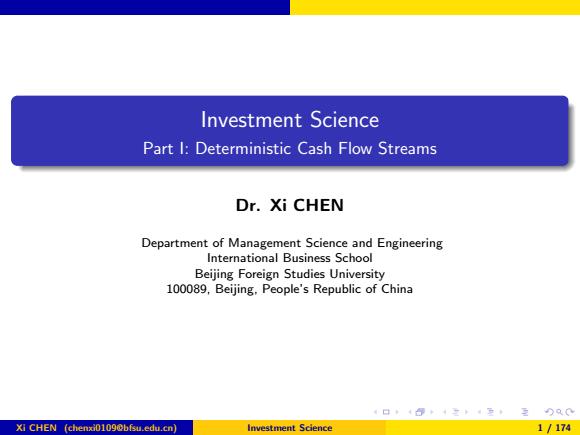
Investment Science Part l:Deterministic Cash Flow Streams Dr.Xi CHEN Department of Management Science and Engineering International Business School Beijing Foreign Studies University 100089,Beijing.People's Republic of China 4口40+4之4至,至)只0 Xi CHEN (chenxi01090bfsu.edu.cn) Investment Science 1/174
Investment Science Part I: Deterministic Cash Flow Streams Dr. Xi CHEN Department of Management Science and Engineering International Business School Beijing Foreign Studies University 100089, Beijing, People’s Republic of China Xi CHEN (chenxi0109@bfsu.edu.cn) Investment Science 1 / 174
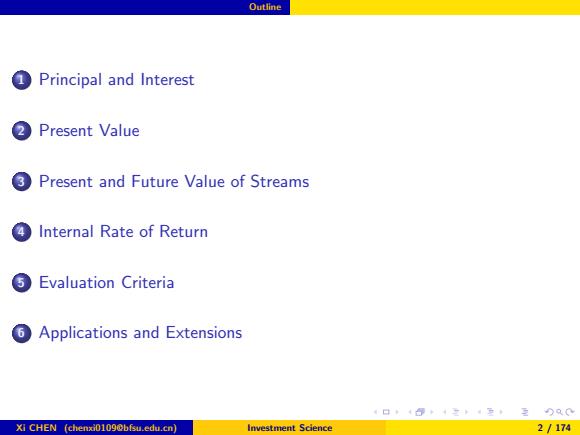
Outline Principal and Interest ② Present Value Present and Future Value of Streams 4 Internal Rate of Return Evaluation Criteria Applications and Extensions 4口4+4三4至,至)只0 Xi CHEN (chenxi01090bfsu.edu.cn) Investment Science 2/174
Outline 1 Principal and Interest 2 Present Value 3 Present and Future Value of Streams 4 Internal Rate of Return 5 Evaluation Criteria 6 Applications and Extensions Xi CHEN (chenxi0109@bfsu.edu.cn) Investment Science 2 / 174
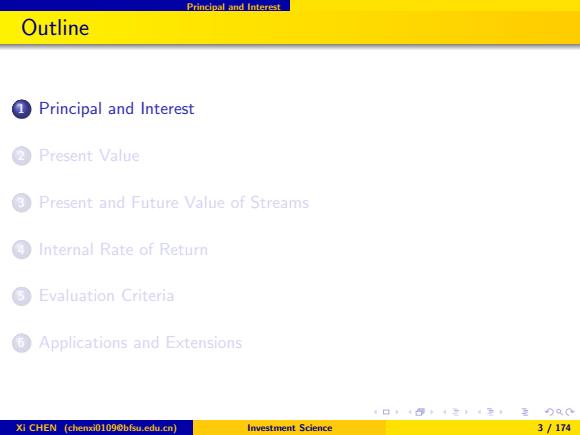
Principal and Interest Outline Principal and Interest Present Value 3 Present and Future Value of Streams Internal Rate of Return Evaluation Criteria Applications and Extensions 4口40+4三4至,至)只0 Xi CHEN (chenxi01090bfsu.edu.cn) Investment Science 3/174
Principal and Interest Outline 1 Principal and Interest 2 Present Value 3 Present and Future Value of Streams 4 Internal Rate of Return 5 Evaluation Criteria 6 Applications and Extensions Xi CHEN (chenxi0109@bfsu.edu.cn) Investment Science 3 / 174
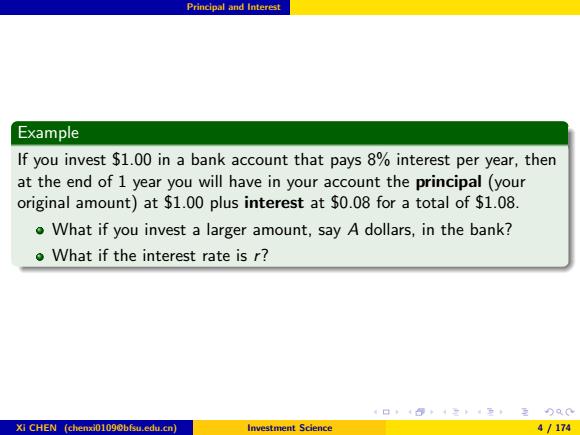
Principal and Interest Example If you invest $1.00 in a bank account that pays 8%interest per year,then at the end of 1 year you will have in your account the principal(your original amount)at $1.00 plus interest at $0.08 for a total of $1.08. o What if you invest a larger amount,say A dollars,in the bank? o What if the interest rate is r? Xi CHEN (chenxi01090bfsu.edu.cn) Investment Science 4/174
Principal and Interest Example If you invest $1.00 in a bank account that pays 8% interest per year, then at the end of 1 year you will have in your account the principal (your original amount) at $1.00 plus interest at $0.08 for a total of $1.08. What if you invest a larger amount, say A dollars, in the bank? What if the interest rate is r? Xi CHEN (chenxi0109@bfsu.edu.cn) Investment Science 4 / 174
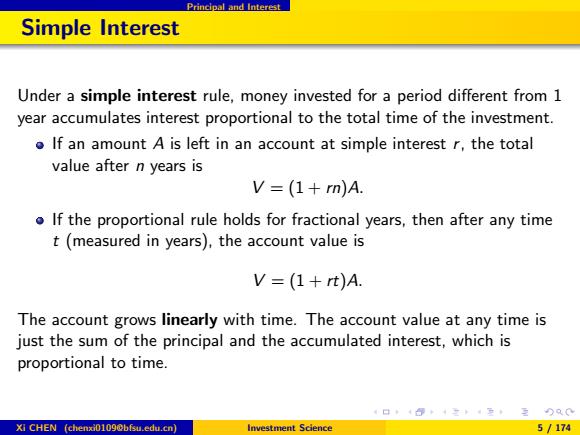
Principal and Interest Simple Interest Under a simple interest rule,money invested for a period different from 1 year accumulates interest proportional to the total time of the investment. If an amount A is left in an account at simple interest r,the total value after n years is V=(1+n)A. o If the proportional rule holds for fractional years,then after any time t(measured in years),the account value is V=(1+t)A. The account grows linearly with time.The account value at any time is just the sum of the principal and the accumulated interest,which is proportional to time. 4口,4得+4之卡4至卡 Xi CHEN (chenxi01090bfsu.edu.cn) Investment Science 5/174
Principal and Interest Simple Interest Under a simple interest rule, money invested for a period different from 1 year accumulates interest proportional to the total time of the investment. If an amount A is left in an account at simple interest r, the total value after n years is V = (1 + rn)A. If the proportional rule holds for fractional years, then after any time t (measured in years), the account value is V = (1 + rt)A. The account grows linearly with time. The account value at any time is just the sum of the principal and the accumulated interest, which is proportional to time. Xi CHEN (chenxi0109@bfsu.edu.cn) Investment Science 5 / 174